A Comprehensive Analysis of Clinical Trials in the COVID-19 Pandemic Era
Abstract
1. Introduction
2. Materials and Methods
2.1. Data Source and Eligible Study
2.2. Study Variables
2.3. Statistical Analysis
3. Results
3.1. Baseline Characteristics of Registered Clinical Trials
3.2. Studies Registered as Randomized Controlled Trials
3.3. Study Registered as Non-Randomized Controlled Trials
3.4. Study Registered as Observational Trials
4. Discussion
5. Conclusions
Supplementary Materials
Author Contributions
Funding
Conflicts of Interest
References
- Huang, C.; Wang, Y.; Li, X.; Ren, L.; Zhao, J.; Hu, Y.; Zhang, L.; Fan, G.; Xu, J.; Gu, X.; et al. Clinical features of patients infected with 2019 novel coronavirus in Wuhan, China. Lancet 2020, 395, 497–506. [Google Scholar] [CrossRef]
- Chan, J.F.-W.; Yuan, S.; Kok, K.-H.; To, K.K.-W.; Chu, H.; Yang, J.; Xing, F.; Liu, J.; Yip, C.C.-Y.; Poon, R.W.-S.; et al. A familial cluster of pneumonia associated with the 2019 novel coronavirus indicating person-to-person transmission: A study of a family cluster. Lancet 2020, 395, 514–523. [Google Scholar] [CrossRef]
- De Angelis, C.; Drazen, J.M.; Frizelle, F.A.; Haug, C.; Hoey, J.; Horton, R.; Kotzin, S.; Laine, C.; Marusic, A.; Overbeke, A.J.P.; et al. Clinical Trial Registration: A Statement from the International Committee of Medical Journal Editors. N. Engl. J. Med. 2004, 351, 1250–1251. [Google Scholar] [CrossRef] [PubMed]
- Mehta, N.; Mazer-Amirshahi, M.; Alkindi, N.; Pourmand, A. Pharmacotherapy in COVID-19; A narrative review for emergency providers. Am. J. Emerg. Med. 2020. [Google Scholar] [CrossRef]
- Liu, J.; Cao, R.; Xu, M.; Wang, X.; Zhang, H.; Hu, H.; Li, Y.; Hu, Z.; Zhong, W.; Wang, M. Hydroxychloroquine, a less toxic derivative of chloroquine, is effective in inhibiting SARS-CoV-2 infection in vitro. Cell Discov. 2020, 6, 1–4. [Google Scholar] [CrossRef] [PubMed]
- Yao, X.; Ye, F.; Zhang, M.; Cui, C.; Huang, B.; Niu, P.; Liu, X.; Zhao, L.; Dong, E.; Song, C.; et al. In Vitro Antiviral Activity and Projection of Optimized Dosing Design of Hydroxychloroquine for the Treatment of Severe Acute Respiratory Syndrome Coronavirus 2 (SARS-CoV-2). Clin. Infect. Dis. 2020. [Google Scholar] [CrossRef] [PubMed]
- Gautret, P.; Lagier, J.-C.; Parola, P.; Hoang, V.T.; Meddeb, L.; Mailhe, M.; Doudier, B.; Courjon, J.; Giordanengo, V.; Vieira, V.E.; et al. Hydroxychloroquine and azithromycin as a treatment of COVID-19: Results of an open-label non-randomized clinical trial. Int. J. Antimicrob. Agents 2020, 105949. [Google Scholar] [CrossRef]
- Taccone, F.S.; Gorham, J.; Vincent, J.-L. Hydroxychloroquine in the management of critically ill patients with COVID-19: The need for an evidence base. Lancet Respir. Med. 2020, 8, 539–541. [Google Scholar] [CrossRef]
- Wang, M.; Cao, R.; Zhang, L.; Yang, X.; Liu, J.; Xu, M.; Shi, Z.; Hu, Z.; Zhong, W.; Xiao, G. Remdesivir and chloroquine effectively inhibit the recently emerged novel coronavirus (2019-nCoV) in vitro. Cell Res. 2020, 30, 269–271. [Google Scholar] [CrossRef]
- Vincent, M.J.; Bergeron, E.; Benjannet, S.; Erickson, B.R.; Rollin, P.E.; Ksiazek, T.G.; Seidah, N.G.; Nichol, S.T. Chloroquine is a potent inhibitor of SARS coronavirus infection and spread. Virol. J. 2005, 2, 69. [Google Scholar] [CrossRef] [PubMed]
- Molina, J.M.; Delaugerre, C.; Le Goff, J.; Mela-Lima, B.; Ponscarme, D.; Goldwirt, L.; De Castro, N. No evidence of rapid antiviral clearance or clinical benefit with the combination of hydroxychloroquine and azithromycin in patients with severe COVID-19 infection. Med. Mal. Infect. 2020. [Google Scholar] [CrossRef] [PubMed]
- Borba, M.G.S.; Val, F.F.A.; Sampaio, V.S.; Alexandre, M.A.A.; Melo, G.C.; Brito, M.; Mourão, M.P.G.; Brito-Sousa, J.D.; Baía-Da-Silva, D.; Guerra, M.V.F.; et al. Effect of High vs Low Doses of Chloroquine Diphosphate as Adjunctive Therapy for Patients Hospitalized With Severe Acute Respiratory Syndrome Coronavirus 2 (SARS-CoV-2) Infection: A Randomized Clinical Trial. JAMA Netw. Open 2020, 3, e208857. [Google Scholar] [CrossRef]
- Channappanavar, R.; Lu, L.; Xia, S.; Du, L.; Meyerholz, D.K.; Perlman, S.; Jiang, S. Protective Effect of Intranasal Regimens Containing Peptidic Middle East Respiratory Syndrome Coronavirus Fusion Inhibitor Against MERS-CoV Infection. J. Infect. Dis. 2015, 212, 1894–1903. [Google Scholar] [CrossRef] [PubMed]
- Morra, M.E.; Van Thanh, L.; Kamel, M.G.; Ghazy, A.A.; Altibi, A.M.; Dat, L.M.; Thy, T.N.X.; Vuong, N.L.; Mostafa, M.R.; Ahmed, S.I.; et al. Clinical outcomes of current medical approaches for Middle East respiratory syndrome: A systematic review and meta-analysis. Rev. Med. Virol. 2018, 28, e1977. [Google Scholar] [CrossRef]
- Chan, K.S.; Lai, S.T.; Chu, C.M.; Tsui, E.; Tam, C.Y.; Wong, M.M.L.; Tse, M.W.; Que, T.L.; Peiris, J.S.M.; Sung, J.; et al. Treatment of severe acute respiratory syndrome with lopinavir/ritonavir: A multicentre retrospective matched cohort study. Hong Kong Med. J. 2003, 9, 399–406. [Google Scholar]
- Wu, J.; Li, W.; Shi, X.; Chen, Z.; Jiang, B.; Liu, J.; Wang, D.; Liu, C.; Meng, Y.; Cui, L.; et al. Early antiviral treatment contributes to alleviate the severity and improve the prognosis of patients with novel coronavirus disease (COVID-19). J. Intern. Med. 2020. [Google Scholar] [CrossRef]
- Cao, B.; Wang, Y.; Wen, D.; Liu, W.; Wang, J.; Fan, G.; Ruan, L.; Song, B.; Cai, Y.; Wei, M.; et al. A Trial of Lopinavir–Ritonavir in Adults Hospitalized with Severe Covid-19. N. Engl. J. Med. 2020, 382, 1787–1799. [Google Scholar] [CrossRef]
- De Wit, E.; Feldmann, F.; Cronin, J.; Jordan, R.; Okumura, A.; Thomas, T.; Scott, D.; Cihlar, T.; Feldmann, H. Prophylactic and therapeutic remdesivir (GS-5734) treatment in the rhesus macaque model of MERS-CoV infection. Proc. Natl. Acad. Sci. USA 2020, 117, 6771–6776. [Google Scholar] [CrossRef]
- Sheahan, T.P.; Sims, A.C.; Leist, S.R.; Schäfer, A.; Won, J.; Brown, A.J.; Montgomery, S.A.; Hogg, A.; Babusis, D.; Clarke, M.O.; et al. Comparative therapeutic efficacy of remdesivir and combination lopinavir, ritonavir, and interferon beta against MERS-CoV. Nat. Commun. 2020, 11, 222. [Google Scholar] [CrossRef] [PubMed]
- Grein, J.; Ohmagari, N.; Shin, D.; Diaz, G.; Asperges, E.; Castagna, A.; Feldt, T.; Green, G.; Green, M.L.; Lescure, F.-X.; et al. Compassionate Use of Remdesivir for Patients with Severe Covid-19. N. Engl. J. Med. 2020, 382, 2327–2336. [Google Scholar] [CrossRef] [PubMed]
- Zhang, S.; Li, L.; Shen, A.; Chen, Y.; Qi, Z. Rational use of tocilizumab in the treatment of novel coronavirus pneumonia. Clin. Drug Investig. 2020. [Google Scholar] [CrossRef] [PubMed]
- Mehta, P.; McAuley, D.F.; Brown, M.; Sanchez, E.; Tattersall, R.S.; Manson, J.J. COVID-19: Consider cytokine storm syndromes and immunosuppression. Lancet 2020, 395, 1033–1034. [Google Scholar] [CrossRef]
- Zhang, W.; Zhao, Y.; Zhang, F.; Wang, Q.; Li, T.; Liu, Z.; Wang, J.; Qin, Y.; Zhang, X.; Yan, X.; et al. The use of anti-inflammatory drugs in the treatment of people with severe coronavirus disease 2019 (COVID-19): The Perspectives of clinical immunologists from China. Clin. Immunol. 2020, 214, 108393. [Google Scholar] [CrossRef] [PubMed]
- Favalli, E.; Ingegnoli, F.; De Lucia, O.; Cincinelli, G.; Cimaz, R.; Caporali, R. COVID-19 infection and rheumatoid arthritis: Faraway, so close! Autoimmun. Rev. 2020, 102523. [Google Scholar] [CrossRef]
- Richardson, P.; Griffin, I.; Tucker, C.; Smith, D.; Oechsle, O.; Phelan, A.; Stebbing, J. Baricitinib as potential treatment for 2019-nCoV acute respiratory disease. Lancet 2020, 395, e30–e31. [Google Scholar] [CrossRef]
- Ho, J.C.-M.; Ooi, G.C.; Mok, T.Y.; Chan, J.W.; Hung, I.F.-N.; Lam, B.; Wong, P.C.; Li, P.C.; Ho, P.L.; Lam, W.K.; et al. High–Dose Pulse Versus Nonpulse Corticosteroid Regimens in Severe Acute Respiratory Syndrome. Am. J. Respir. Crit. Care Med. 2003, 168, 1449–1456. [Google Scholar] [CrossRef] [PubMed]
- Auyeung, T.W.; Lee, J.; Lai, W.K.; Choi, C.H.; Lee, H.K.; Li, P.C.; Lok, K.H.; Ng, Y.Y.; Wong, W.M.; Lee, J.S.; et al. The use of corticosteroid as treatment in SARS was associated with adverse outcomes: A retrospective cohort study. J. Infect. 2005, 51, 98–102. [Google Scholar] [CrossRef] [PubMed]
- Hui, D.S. Systemic Corticosteroid Therapy May Delay Viral Clearance in Patients with Middle East Respiratory Syndrome Coronavirus Infection. Am. J. Respir. Crit. Care Med. 2018, 197, 700–701. [Google Scholar] [CrossRef]
- Arabi, Y.M.; Mandourah, Y.; Al-Hameed, F.; Sindi, A.A.; Almekhlafi, G.A.; Hussein, M.A.; Jose, J.; Pinto, R.; Al-Omari, A.; Kharaba, A.; et al. Corticosteroid Therapy for Critically Ill Patients with Middle East Respiratory Syndrome. Am. J. Respir. Crit. Care Med. 2018, 197, 757–767. [Google Scholar] [CrossRef] [PubMed]
- Russell, C.D.; Millar, J.E.; Baillie, J.K. Clinical evidence does not support corticosteroid treatment for 2019-nCoV lung injury. Lancet 2020, 395, 473–475. [Google Scholar] [CrossRef]
- Shang, L.; Zhao, J.; Hu, Y.; Du, R.; Cao, B. On the use of corticosteroids for 2019-nCoV pneumonia. Lancet 2020, 395, 683–684. [Google Scholar] [CrossRef]
- Misawa, T.; Takahama, M.; Kozaki, T.; Lee, H.; Zou, J.; Saitoh, T.; Akira, S. Microtubule-driven spatial arrangement of mitochondria promotes activation of the NLRP3 inflammasome. Nat. Immunol. 2013, 14, 454–460. [Google Scholar] [CrossRef] [PubMed]
- Deftereos, S.G.; Siasos, G.; Giannopoulos, G.; Vrachatis, D.A.; Angelidis, C.; Giotaki, S.G.; Gargalianos, P.; Giamarellou, H.; Gogos, C.; Daikos, G.; et al. The GReek study in the Effects of Colchicine in COvid-19 complications prevention (GRECCO-19 study): Rationale and study design. Hell. J. Cardiol. 2020. [Google Scholar] [CrossRef] [PubMed]
- Deftereos, S.; Giannopoulos, G.; Vrachatis, D.A.; Siasos, G.; Giotaki, S.G.; Cleman, M.; Dangas, G.; Stefanadis, C. Colchicine as a potent anti-inflammatory treatment in COVID-19: Can we teach an old dog new tricks? Eur. Hear J. Cardiovasc. Pharmacother. 2020. [Google Scholar] [CrossRef] [PubMed]
- Gentile, P.; Sterodimas, A. Adipose-derived stromal stem cells (ASCs) as a new regenerative immediate therapy combating coronavirus (COVID-19)-induced pneumonia. Expert Opin. Biol. Ther. 2020, 1–6. [Google Scholar] [CrossRef] [PubMed]
- Weijer, C.; Shapiro, S.H.; Glass, K.C.; Enkin, M.W. For and against: Clinical equipoise and not the uncertainty principle is the moral underpinning of the randomised controlled trial FOR AGAINST. BMJ 2000, 321, 756–758. [Google Scholar] [CrossRef]
- Rabinstein, A.A.; Brinjikji, W.; Kallmes, D. Equipoise in Clinical Trials. Circ. Res. 2016, 119, 798–800. [Google Scholar] [CrossRef] [PubMed]
- Greisen, G.; Van Bel, F. Equipoise is necessary for randomising patients to clinical trials. Acta Paediatr. 2016, 105, 1259–1260. [Google Scholar] [CrossRef] [PubMed]
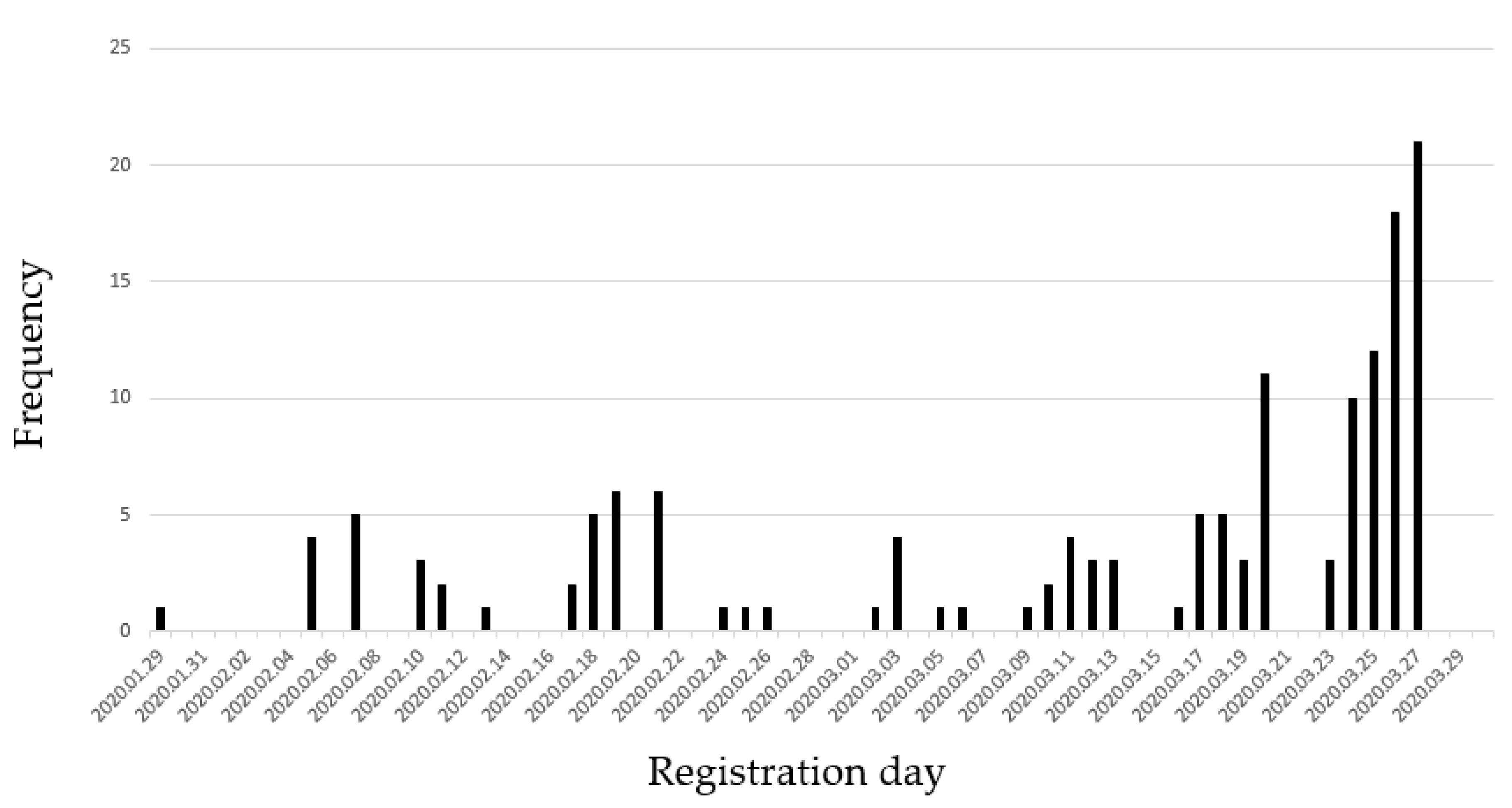
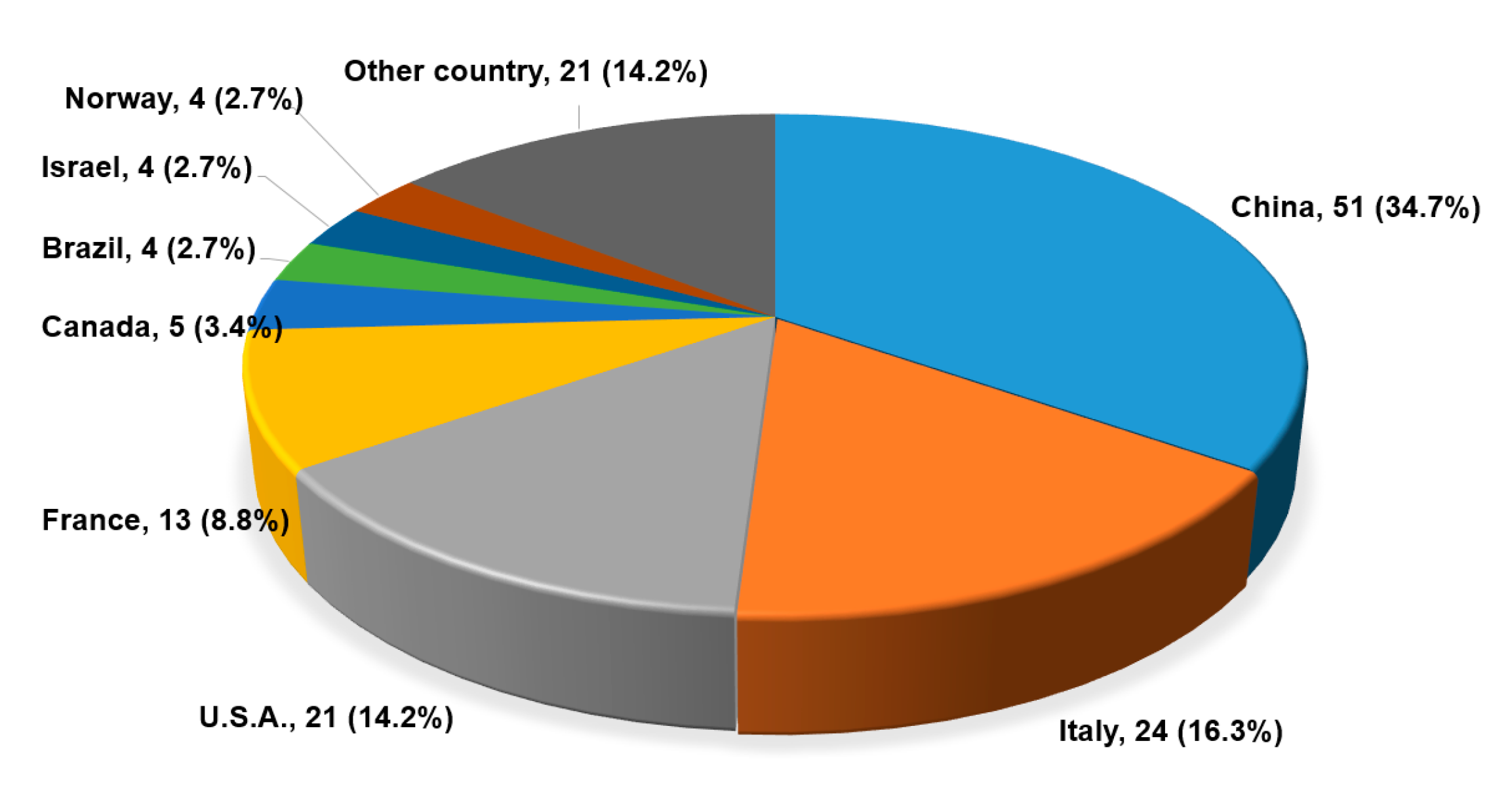
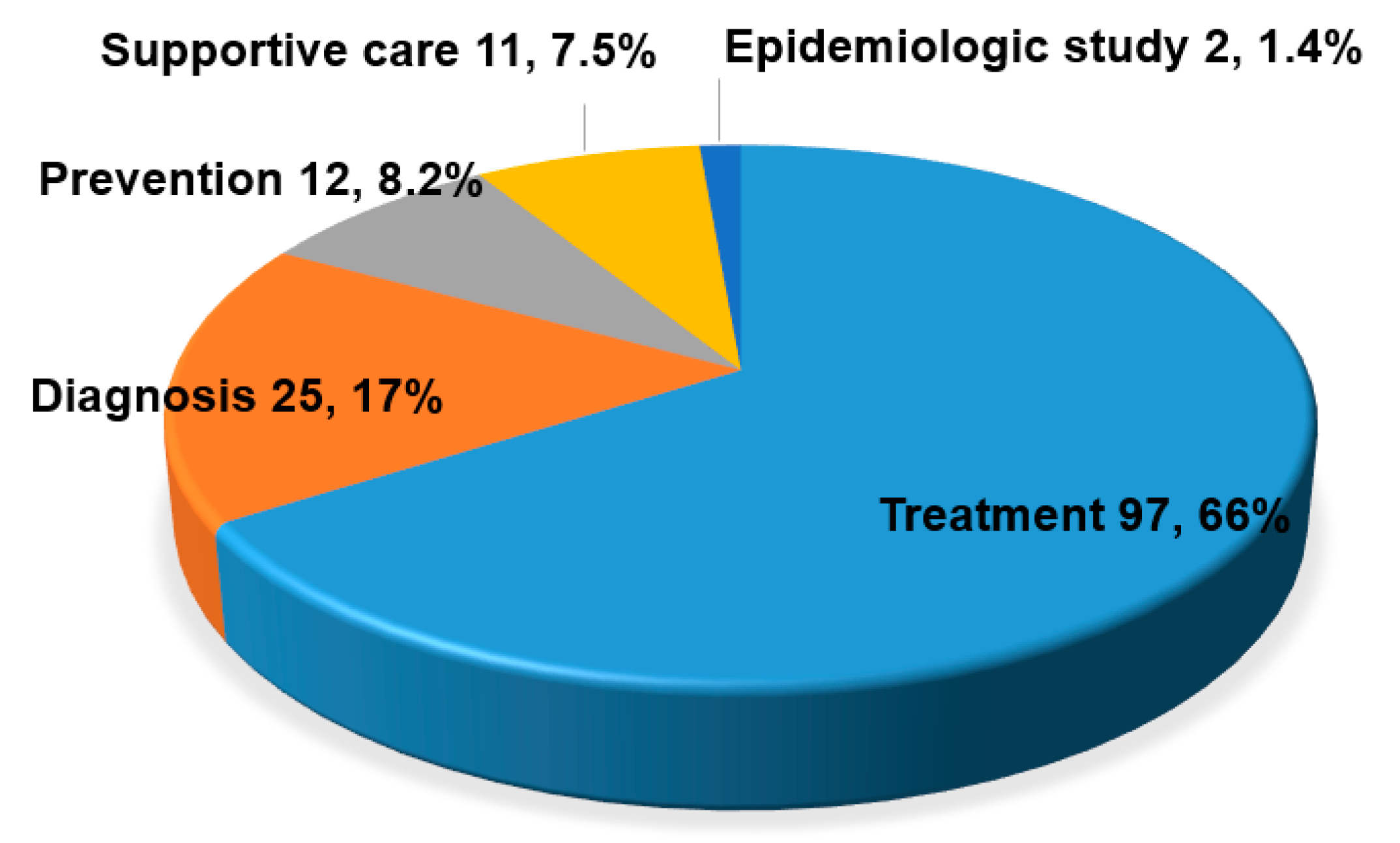
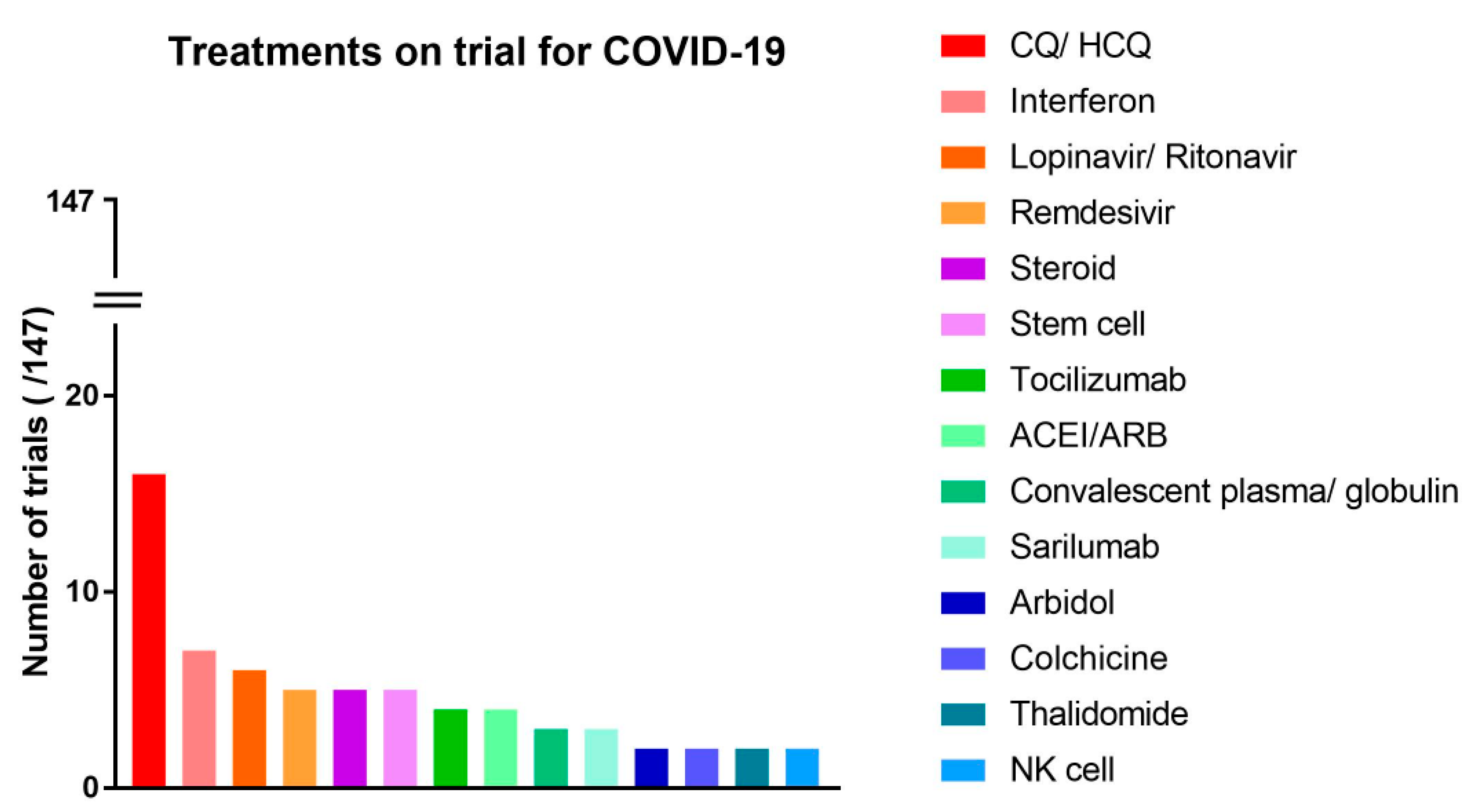
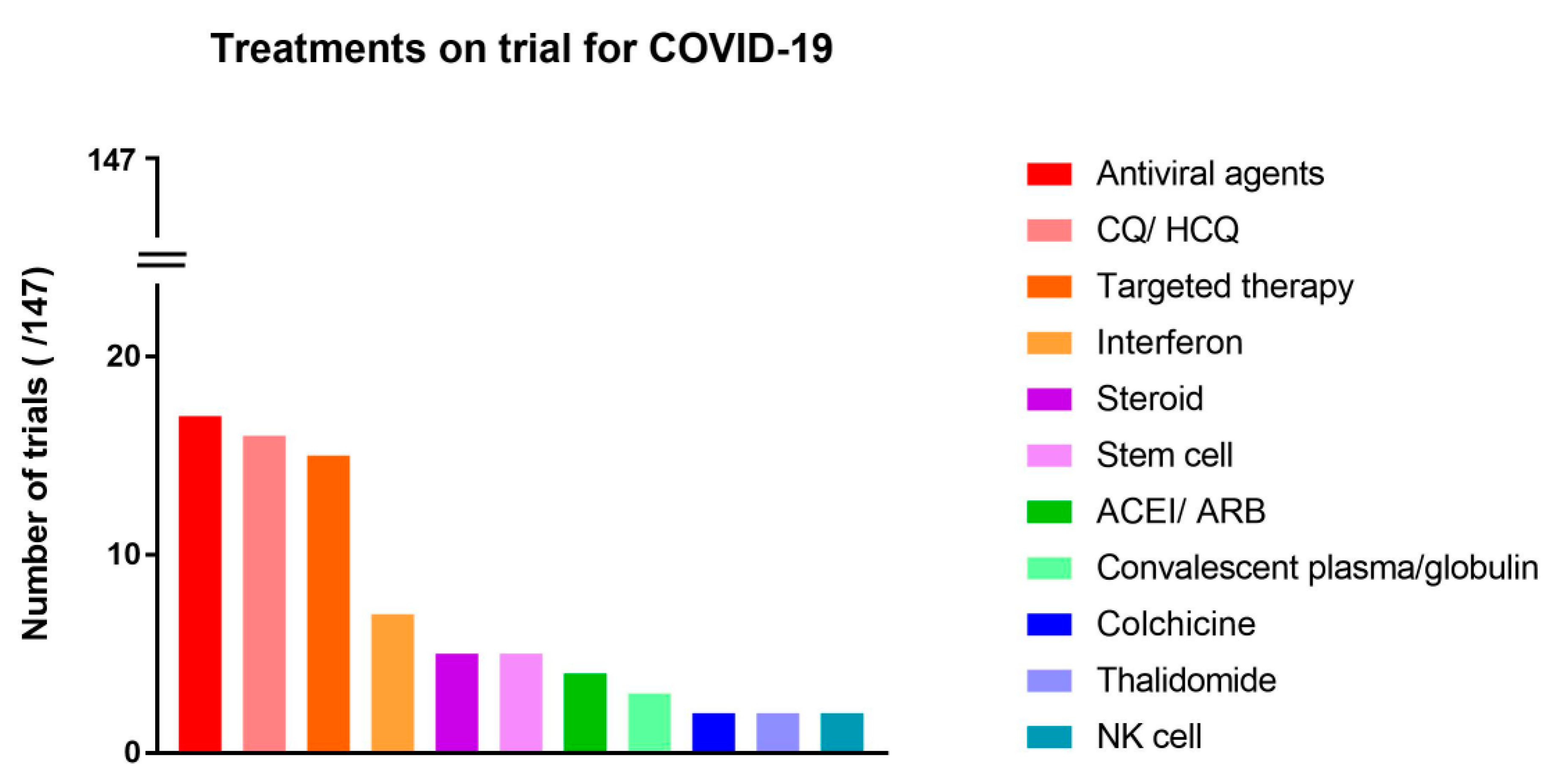
| China (n = 19) | Studies Outside China (n = 44) | p-Value | |
| Planned Enrollment | 136.2 ± 114.6 | 1944.9 ± 6109.6 | 0.204 |
| Blinded | 11 (57.9%) | 24 (54.5%) | 0.806 |
| Multicenter | 7 (36·8%) | 16 (36·4%) | 0.971 |
| Multi-Country | 0 (0%) | 3 (6·8%) | 0.547 |
| Sponsor (Industry) | 1 (5.3%) | 10 (22.7%) | 0.150 |
| Blinded (n = 35) | Open Label (n = 28) | ||
| Planned Enrollment | 1933.8 ± 6817.7 | 731.4 ± 1303.5 | 0.362 |
| China | 11 (31.4%) | 8 (28.6%) | 0.806 |
| Multicenter | 9 (25.7%) | 14 (50.0%) | 0.047 |
| Multi-Country | 1 (2.9%) | 2 (7.1%) | 0.560 |
| Sponsor (Industry) | 7 (20.0%) | 4 (14.3%) | 0.553 |
| Multicenter (n = 23) | Single Center (n = 40) | ||
| Planned enrollment | 959.9 ± 1719.9 | 1652.2 ± 6358.2 | 0.612 |
| China | 7 (30.4%) | 12 (30.0%) | 0.971 |
| Blinded | 9 (39.1%) | 26 (65.0%) | 0.047 |
| Multi-Country | 3 (13.0%) | 0 (0%) | 0.045 |
| Sponsor (Industry) | 5 (21.7%) | 6 (15.0%) | 0.498 |
| Multi-Country (n = 3) | Single Country (n = 60) | ||
| Planned Enrollment | 2573.3 ± 3058.5 | 1340.7 ±5249.2 | 0.690 |
| China | 0 (0%) | 19 (31.7%) | 0.547 |
| Blinded | 1 (33.3%) | 34 (56.7%) | 0.427 |
| Multicenter | 3 (100%) | 20 (33.3%) | 0.045 |
| Sponsor (Industry) | 3 (100%) | 8 (13.3%) | 0.004 |
| Sponsor (Industry) (n = 11) | Researcher (n = 52) | ||
| Planned Enrollment | 905.8 ± 1744.6 | 1503.9 ± 5627.4 | 0.730 |
| China | 1 (9.1%) | 18 (34.6%) | 0.150 |
| Blinded | 7 (63.6%) | 28 (53.8%) | 0.741 |
| Multicenter | 5 (45.5%) | 18 (34.6%) | 0.511 |
| Multi-Country | 3 (27.3%) | 0 (0%) | 0.004 |
| China (n = 14) | Outside of China (n = 15) | p-Value | |
| Participant | 260.0 ± 775.0 | 247.9 ± 294.9 | 0.955 |
| Multicenter | 3 (21.4%) | 4 (26.7%) | 1.000 |
| Sponsor (Industry) | 2 (14.3%) | 2 (13.3%) | 1.000 |
| Single Group | 10 (71.4%) | 3 (66·7%) | 1.000 |
| Single Arm | 10 (74.4%) | 9 (60.0%) | 0.700 |
| Multicenter (n = 7) | Single Center (n = 22) | ||
| Participant | 354.3 ± 336.0 | 221.7 ± 627.0 | 0.600 |
| China | 3 (42.9%) | 11 (50.0%) | 1.000 |
| Sponsor (Industry) | 1 (14.3%) | 3 (13.6%) | 1.000 |
| Single Group | 5 (71.4%) | 15 (68.2%) | 1.000 |
| Single Arm | 5 (71.4%) | 14 (63.6%) | 1.000 |
| Sponsor (Industry) (n = 4) | Researcher (n = 25) | ||
| Participant | 299.5 ± 468.3 | 246.4 ± 590.2 | 0.866 |
| China | 2 (50.0%) | 12 (48.0%) | 1.000 |
| Multicenter | 1 (25.0%) | 6 (24.0%) | 1.000 |
| Single Group | 2 (50.0%) | 18 (72.0%) | 0.568 |
| Single Arm | 1 (25.0%) | 18 (72.0%) | 0.105 |
| Single Group (n = 20) | Parallel Group (n = 9) | ||
| Participant | 122.9 ± 170.4 | 544.6 ± 959.9 | 0.226 |
| China | 10 (50.0%) | 4 (44.4%) | 1.000 |
| Multicenter | 5 (25.0%) | 2 (22.2%) | 1.000 |
| Sponsor (Industry) | 2 (10.0%) | 2 (22.2%) | 0.568 |
| Single Arm | 18 (90.0%) | 1 (11.1%) | <0.001 |
| Single Arm (Industry) (n = 19) | Non-Randomized (n = 10) | ||
| Participant | 151.1 ± 203.5 | 448.7 ± 925.1 | 0.340 |
| China | 10 (52.6%) | 4 (40.0%) | 0.700 |
| Multicenter | 5 (26.3%) | 2 (20.0%) | 1.000 |
| Sponsor (Industry) | 1 (5.3%) | 3 (30.0%) | 0.105 |
| Single Group | 18 (94.7%) | 2 (20.0%) | <0.001 |
| China (n = 20) | Outside of China (n = 35) | p-Value | |
| Participant | 17,264.1 ± 66,918.8 | 6494.9 ± 20,004.3 | 0.377 |
| Prospective | 12 (60.0%) | 32 (91.4%) | 0.011 |
| Multicenter | 4 (20.0%) | 4 (11.4%) | 0.443 |
| Sponsor (Industry) | 1 (5.0%) | 1 (2.9%) | 1.000 |
| Prospective (n = 44) | Retrospective (n = 11) | ||
| Participant | 12,849.8 ± 47,942.9 | 655.6 ± 1454.2 | 0.406 |
| China | 12 (27.3%) | 8 (72.7%) | 0.011 |
| Multicenter | 7 (15.9%) | 1 (9.1%) | 1.000 |
| Sponsor (Industry) | 2 (4.5%) | 0 (0%) | 1.000 |
| Multicenter (n = 8) | Single Center (n = 47) | ||
| Participant | 10,089.8 ± 19,219.4 | 10,465.7 ± 46,057.5 | 0.982 |
| China | 4 (50.0%) | 16 (34.0%) | 0.443 |
| Prospective | 7 (87.5%) | 37 (78.7%) | 1.000 |
| Sponsor (Industry) | 0 (0%) | 2 (4.3%) | 1.000 |
| Sponsor (Industry) (n = 2) | Researcher (n = 53) | ||
| Participant | 210.0 ± 127.3 | 10,795.9 ± 43,842.0 | 0.736 |
| China | 1 (50.0%) | 19 (35.8%) | 1.000 |
| Prospective | 2 (100%) | 42 (79.2%) | 1.000 |
| Multicenter | 0 (0%) | 8 (15.1%) | 1.000 |
© 2020 by the authors. Licensee MDPI, Basel, Switzerland. This article is an open access article distributed under the terms and conditions of the Creative Commons Attribution (CC BY) license (http://creativecommons.org/licenses/by/4.0/).
Share and Cite
Lee, J.; Shin, H.W.; Lee, J.Y.; Kim, J.S.; Yang, J.W.; Lee, K.H.; Kronbichler, A.; Shin, J.I. A Comprehensive Analysis of Clinical Trials in the COVID-19 Pandemic Era. Medicina 2020, 56, 315. https://doi.org/10.3390/medicina56060315
Lee J, Shin HW, Lee JY, Kim JS, Yang JW, Lee KH, Kronbichler A, Shin JI. A Comprehensive Analysis of Clinical Trials in the COVID-19 Pandemic Era. Medicina. 2020; 56(6):315. https://doi.org/10.3390/medicina56060315
Chicago/Turabian StyleLee, Jinhee, Han Wul Shin, Jun Young Lee, Jae Seok Kim, Jae Won Yang, Keum Hwa Lee, Andreas Kronbichler, and Jae Il Shin. 2020. "A Comprehensive Analysis of Clinical Trials in the COVID-19 Pandemic Era" Medicina 56, no. 6: 315. https://doi.org/10.3390/medicina56060315
APA StyleLee, J., Shin, H. W., Lee, J. Y., Kim, J. S., Yang, J. W., Lee, K. H., Kronbichler, A., & Shin, J. I. (2020). A Comprehensive Analysis of Clinical Trials in the COVID-19 Pandemic Era. Medicina, 56(6), 315. https://doi.org/10.3390/medicina56060315







